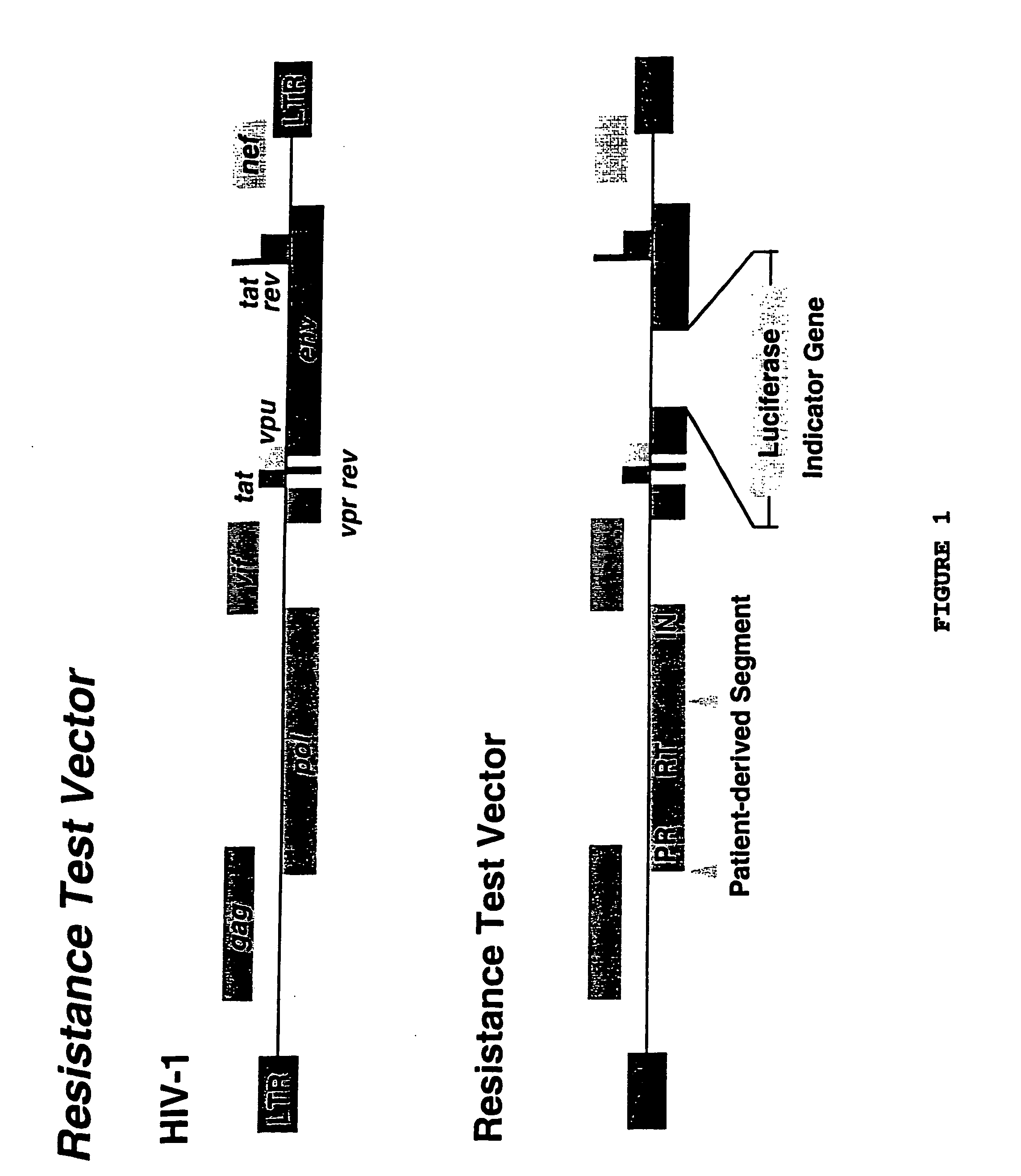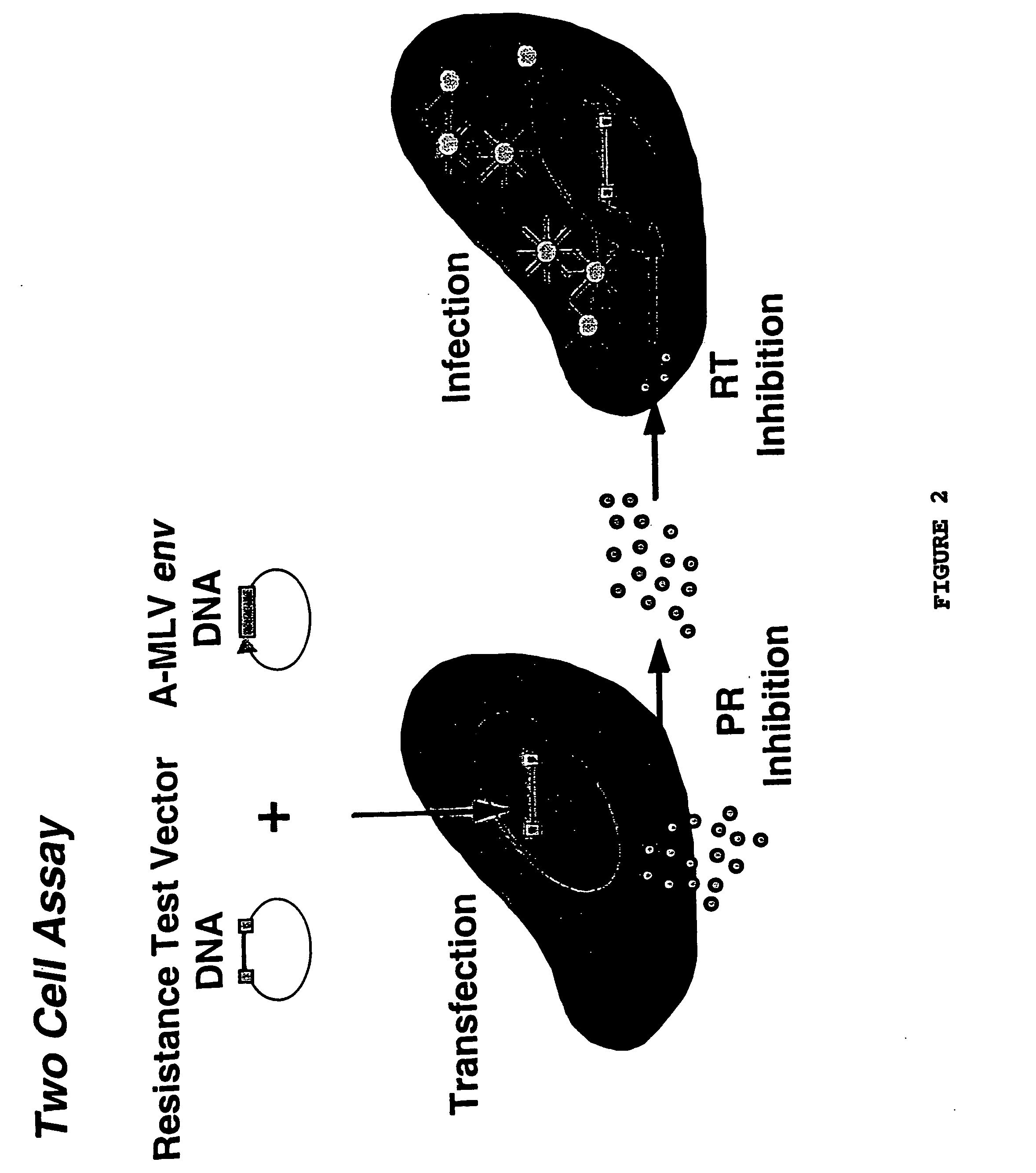Means and methods for monitoring non-nucleoside reverse transcriptase inhibitor antiretroviral therapy and guiding therapeutic decisions in the treatment HIV-AIDS
a reverse transcriptase inhibitor and antiretroviral therapy technology, applied in the field of antiretroviral drug susceptibility and resistance tests, can solve the problems of small proportion of the total viral load, small tolerability of drug regimens, and disease progression, and achieve little or no change in nevirapine susceptibility, increase in delavirdine susceptibility, and decrease in the susceptibility to delavirdine
- Summary
- Abstract
- Description
- Claims
- Application Information
AI Technical Summary
Benefits of technology
Problems solved by technology
Method used
Image
Examples
example 1
Phenotypic Drug Susceptibility and Resistance Test Using Resistance Test Vectors
[0155] Phenotypic drug susceptibility and resistance tests are carried out using the means and methods described in PCT International Application No. PCT / US97 / 01609, filed Jan. 29, 1997 which is hereby incorporated by reference.
[0156] In these experiments patient-derived segment(s) corresponding to the HIV protease and reverse transcriptase coding regions were either patient-derived segments amplified by the reverse transcription-polymerase chain reaction method (RT-PCR) using viral RNA isolated from viral particles present in the serum of HIV-infected individuals or were mutants of wild type HIV-1 made by site directed mutagenesis of a parental clone of resistance test vector DNA. Isolation of viral RNA was performed using standard procedures (e.g. RNAgents Total RNA Isolation System, Promega, Madison Wis. or RNAzol, Tel-Test, Friendswood, Tex.). The RT-PCR protocol was divided into two steps. A retro...
example 2
Correlating Phenotypic Susceptibility and Genotypic Analysis Phenotypic Susceptibility Analysis of Patient HIV Samples
[0163] Resistance test vectors are constructed as described in example 1. Resistance test vectors, or clones derived from the resistance test vector pools, are tested in a phenotypic assay to determine accurately and quantitatively the level of susceptibility to a panel of anti-retroviral drugs. This panel of anti-retroviral drugs may comprise members of the classes known as nucleoside-analog reverse transcriptase inhibitors (NRTIs), non-nucleoside reverse transcriptase inhibitors (NNRTIs), and protease inhibitors (PRIs). The panel of drugs can be expanded as new drugs or new drug targets become available. An IC50 is determined for each resistance test vector pool for each drug tested. The pattern of susceptibility to all of the drugs tested is examined and compared to known patterns of susceptibility. A patient sample can be further examined for genotypic changes c...
example 3
Correlating Phenotypic Susceptibility and Genotypic Analysis: P225H
Phenotypic Analysis of Patient 97-302
[0166] A resistance test vector was constructed as described in example 1 from a patient sample designated as 97-302. This patient had been treated with d4T, indinavir and DMP-266 for a period of approximately 10 months. Isolation of viral RNA and RT / PCR was used to generate a patient derived segment that comprised viral sequences coding for all of PR and aa 1-313 of RT. The patient derived segment was inserted into a indicator gene viral vector to generate a resistance test vector designated RTV-302. RTV-302 was tested using a phenotypic susceptibility assay to determine accurately and quantitatively the level of susceptibility to a panel of anti-retroviral drugs. This panel of anti-retroviral drugs comprised members of the classes known as NRTIs (AZT, 3TC, d4T, ddI and ddC), NNRTIs (delavirdine and nevirapine), and PRIs (indinavir, nelfinavir, ritonavir, and saquinavir). An ...
PUM
 Login to View More
Login to View More Abstract
Description
Claims
Application Information
 Login to View More
Login to View More - R&D
- Intellectual Property
- Life Sciences
- Materials
- Tech Scout
- Unparalleled Data Quality
- Higher Quality Content
- 60% Fewer Hallucinations
Browse by: Latest US Patents, China's latest patents, Technical Efficacy Thesaurus, Application Domain, Technology Topic, Popular Technical Reports.
© 2025 PatSnap. All rights reserved.Legal|Privacy policy|Modern Slavery Act Transparency Statement|Sitemap|About US| Contact US: help@patsnap.com



